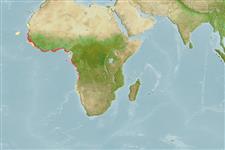Elasmobranchii (haaien en roggen) (sharks and rays) >
Carcharhiniformes (Ground sharks) >
Leptochariidae (Barbeled houndsharks)
Etymology: Leptocharias: Etymology not explained, perhaps leptos (Gr.), slender; [Car]charias, i.e., a slender shark “very nearly related to Carcharias”. (See ETYFish); smithii: In honor of Andrew Smith (1797-1872), Scottish military physician, explorer, ethnologist and zoologist, who collected many South African sharks and coined many of the shark names later used by Müller and Henle. (See ETYFish).
More on authors: Müller & Henle.
Environment: milieu / climate zone / depth range / distribution range
Ecologie
marien; brak water demersaal; diepte 10 - 75 m (Ref. 244), usually 10 - 60 m (Ref. 5377). Tropical; 20°C - 27°C; 22°N - 23°S, 26°W - 17°E
Eastern Atlantic: Mauritania to Namibia (Ref. 127434).
Grootte / Gewicht / Leeftijd
Maturity: Lm ? range ? - ? cm
Max length : 77.0 cm TL mannelijk / geslacht onbekend; (Ref. 244); 82.0 cm TL (female); common length : 55.0 cm TL mannelijk / geslacht onbekend; (Ref. 26999)
Korte beschrijving
Determinatiesleutels | Morfologie | Morfometrie
Similar to species of Mustelus but nostrils with anterior flaps formed into distinct barbels (Ref. 5485).
Found on the continental shelf, especially abundant off river mouths on muddy bottoms. Salinity: 35-36 ppt. Oxygen: 3-4 ppm. Feeds on small bottom and littoral organisms like crustaceans, bony fishes, octopi and sponges. Viviparous (Ref. 50449), with 7 young in a litter (Ref. 244). Dental sexual dimorphism is manifested by males having greatly enlarged anterior teeth. Utilized fresh, smoked or dried salted for human consumption, skin for leather.
Viviparous, placental (Ref. 50449), with 7 young in a litter (Ref. 244). Distinct pairing with embrace (Ref. 205).
Compagno, L.J.V., 1984. FAO Species Catalogue. Vol. 4. Sharks of the world. An annotated and illustrated catalogue of shark species known to date. Part 2 - Carcharhiniformes. FAO Fish. Synop. 125(4/2):251-655. Rome: FAO. (Ref. 244)
Status op de Rode Lijst van het IUCN (Ref. 130435)
Gevaar voor de mens
Harmless
Gebruik door de mens
Visserij: van minder commercieel belang
Tools
Speciale rapporten
Download XML
Internetbronnen
Estimates based on models
Preferred temperature (Ref.
123201): 19.2 - 28, mean 26 °C (based on 116 cells).
Fylogenetische diversiteitsindex (Ref.
82804): PD
50 = 1.5000 [Uniqueness, from 0.5 = low to 2.0 = high].
Bayesian length-weight: a=0.00389 (0.00180 - 0.00842), b=3.12 (2.94 - 3.30), in cm total length, based on all LWR estimates for this body shape (Ref.
93245).
Trofisch niveau (Ref.
69278): 3.8 ±0.49 se; based on food items.
Weerstandsvermogen (Ref.
120179): Zeer laag, minimale populatieverdubbelingstijd meer dan 14 jaar (Fec=7).
Fishing Vulnerability (Ref.
59153): Moderate to high vulnerability (53 of 100).
